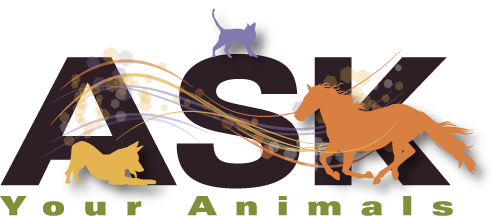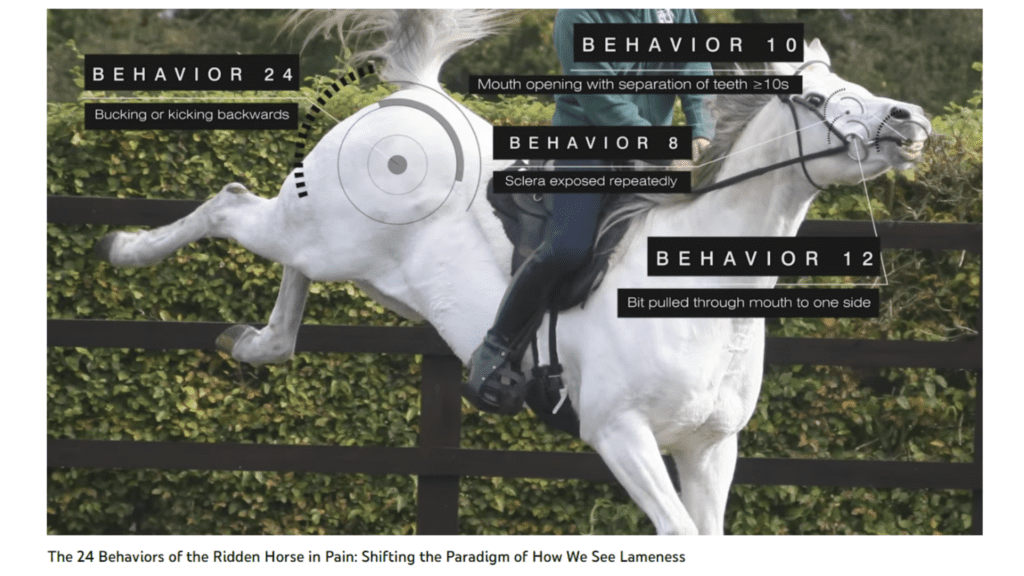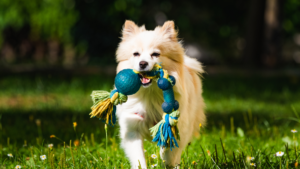Have you ever looked at your horse and just had a “gut feeling” that something was off? How do you determine if that feeling is accurate? How does any horse owner know what is motivating their horses’ “bad behavior”? Is it pain? An illness? A general unhappiness about their environment? The trainer may say that it is poor work ethic, rider error, or just plain naughtiness. The vet may not see any obvious lameness and declare the horse to be sound. Yet, the gut feeling still persists, but where do you look for answers?
Through my 40+ years as a horse owner, equestrian, and equine sports therapist, I have not only experienced it for myself, but I have heard some version of this sad and frustrating story time and time again. I have watched so many of my friends and clients navigate the unexplained behaviors of their beloved horses. The story often sounds like this:
The months go by and I feel the joy has gone from riding. I look at my equine friend and partner and see a dull and listless gaze. I can see he is not happy. I remember the days of laughter, hard work, and accomplishment when we felt powerful together, fit, strong, and forward. The strides felt long and light as we covered the ground, the wind in our hair. Today we trot forward with a stiff feeling back, short strides, and no energy to push on. His ears are back, his tail swishes, and he chomps the bit and stumbles frequently. If I ask for more, we end up in a struggle. He has no more to give. I know in my heart that this is not “bad behavior” or a “poor work ethic”. This is not the result of “poor riding”. This is not the natural state of my beloved horse.
All of the stories sound similar.
“I know something is wrong with my horse but I can’t find the cause.”
“This is not his usual behavior.”
“I know when he is happy and well and this is not it.”
“He is ‘off’ but no one else can see it.”
“My trainer says to push harder, my horse is just being naughty.”
“I have tried everything, massage, acupuncture, Magna Wave, chiropractic, saddle fitter. Everything helps but only temporarily. He is still ‘off’ and reluctant to work.”
So WHAT IS IT? It’s PAIN.
These behaviors are often the early signs of musculoskeletal pain that appear before a lameness can be detected.
Our horses are strong and brave. They work hard for us and try to meet our expectations. They push through the pain. They push and push, doing their jobs despite the pain in their body. They move differently and act differently while they compensate for the pain and continue to work. They work until they no longer can. By the time we detect an obvious head-bobbing lameness, it may be too late to help.
Sadly, our equestrian culture has developed a deaf ear to their pain. We have somehow lost the open dialogue that says, “Hey, my friend, what’s up? You feel a little off today. You’re not yourself. I can feel your back is stiff. Do you need another day of recovery? Maybe some stretching?”
Horses are generally very honest creatures. They don’t try to trick us into giving them a day off. When they are feeling playful and full of energy, they let us know. When they are in pain and honestly unable to perform they also let us know. They communicate with the same body language they use in the herd; stance, posture, facial expression, and willingness to move.
We Need To Trust Our Horses
We, as equestrians, need to practice our listening skills. Listen with our gut and watch with our eyes. If your horse is telling you he is “not himself”, trust him!
When we don’t trust, the frustration is real, painful, and expensive. These are statements I often hear from clients when they are searching for answers in the wrong places.
“My vet can’t see a head bobbing lameness, writes a prescription, and sends an invoice.”
“My trainer pressures me to continue training and competition despite my concern.”
“My horse is losing weight and muscle tone even though he is working regularly. I buy more supplements and treatments for ulcers.”
“I take time off to let him rest…..get radiographs…..try some shockwave….get a second opinion…..how about some joint injections….and still he is acting out under saddle.”
“I bought a new custom saddle and the latest magic pad. Still he bucks.”
Help To Identify Pain is Available
Sue Dyson, VetMB, Ph.D., a world-renowned expert in equine orthopedics, with a particular interest in lameness and poor performance in sports horses, has developed a tool that I hope will change the way we judge horse behavior. Her tool “The Ridden Horse Pain Ethogram (RHpE)”, developed through years of studying behavior in the ridden horse, teaches horse owners, trainers, and medical practitioners a new way of qualifying a horse’s behavior to determine if the horse is experiencing musculoskeletal pain.
An Ethogram is a catalog or table of animal behaviors used to qualify normal vs. abnormal behaviors. You can download this table related to the Ethogram to keep for your reference. When used as a diagnostic tool, this Ethogram can help horse owners to identify and treat pain before the condition progresses and perhaps ends the horses’ riding career. An in-depth application of the Ethogram by NIH is detailed in this study.
The technique for evaluating a horse using the Ethogram can be seen in detail in Dr. Dyson’s film The 24 Behaviors of the Ridden Horse in Pain. I believe this film is a MUST-WATCH for all horse owners. It is 35 minutes which could be the best investment in your horse’s wellness plan.
A General Synopsis of The 24 Behaviors of the Ridden Horse in Pain
The 24 Behaviors of the Ridden Horse in Pain is a film that dares to challenge the way we look at “badly behaving” horses, and promotes the notion that lameness doesn’t start at the head bob. Through a six-phase study, spanning three years, and over 400 horses, Dr. Dyson, and colleagues developed The Ridden Horse Pain Ethogram (RHpE), a tool to reliably predict lameness before the condition worsens into limping and other obvious signs of injuries. The Ridden Horse Pain Ethogram is a catalog of 24 behaviors, which scientific studies have demonstrated can be associated with pain in the ridden horse. The majority of these behaviors are at least ten times more likely to be seen in lame horses compared with non-lame horses.
The film follows Dr. Dyson and Dr. Jim Myers of Gold Coast Equine, as they examine and diagnose show jumper Lauren McMahon’s beloved mare Galina, who was not obviously lame, yet seemed increasingly unhappy under saddle. Lauren had “tried everything” to figure out what was wrong, including ulcer treatments, multiple joint injections, and specialized shoeing but Galina only became more resistant under saddle. Galina’s story is not uncommon for horses that do not present with an obvious head bobbing lameness. Oftentimes these are horses that get labeled as “resistant,” “lazy,” and horses that buck or rear from pain, “explosive.” Trainers often tell riders to “push them through it.”
It also educates horse lovers on how to spot the early signs of pain while taking viewers on an emotional “ride” through the eyes of a young girl who loves her horse and will stop at nothing to try to figure out how to make her comfortable.
Dr. Dyson’s research was further explained in an article published recently in Equus Magazine. An excerpt from the article explains:
“Undiagnosed lameness has a far-reaching impact on the lives of horses and their riders, says Sue Dyson, VetMB, Ph.D. “One of the reasons I was incentivized to develop an RHpE was I had become so dispirited by seeing so many horses who clearly had pain-related problems that had been ignored for far too long,” she explains. “The horse, the rider, the training technique were being blamed over and over again. Coercive training techniques were being used. Longer whips, spurs, tighter nosebands, and ‘stronger’ bits were being employed. Moreover, veterinarians did not understand what they were looking at either—if an enlightened owner sought advice, and there was no obvious lameness seen in hand, they were told that the horse had behavioral problems.”
I hope that you will join me in continuing the conversation with our horses, giving them the opportunity to express their needs through behavior and building trust for a pain-free partnership.
Reference: The 24 Behaviors of the Ridden Horse in Pain: Shifting the Paradigm of How We See Lameness by Padmavideo



